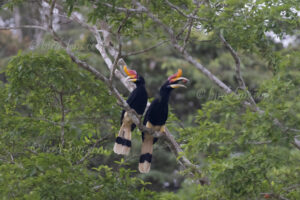 A successful day of bird watching begins with the sighting of a pair of Rhinoceros Hornbill (Buceros rhinoceros) feeding at one of the Fig tree on the banks of the Kinabatangan River together with Pink-necked Green-Pigeon (Treron vernans) and Green Imperial-Pigeon (Ducula aenea) and many more birds at Kinabatangan River. Later we had Bushy-crested Hornbill (Anorrhinus galeritus), White-crowned Hornbill (Aceros comatus), Wrinkled Hornbill (Aceros corrugatus) and Wreathed Hornbill (Aceros undulatus) as well. Kinabatangan River is Hornbill Paradise. But the Kinabatangan River is also home of a viable population of Wallace’s Hawk-Eagle (Spizaetus nanus), which you can see almost every second hour.
A successful day of bird watching begins with the sighting of a pair of Rhinoceros Hornbill (Buceros rhinoceros) feeding at one of the Fig tree on the banks of the Kinabatangan River together with Pink-necked Green-Pigeon (Treron vernans) and Green Imperial-Pigeon (Ducula aenea) and many more birds at Kinabatangan River. Later we had Bushy-crested Hornbill (Anorrhinus galeritus), White-crowned Hornbill (Aceros comatus), Wrinkled Hornbill (Aceros corrugatus) and Wreathed Hornbill (Aceros undulatus) as well. Kinabatangan River is Hornbill Paradise. But the Kinabatangan River is also home of a viable population of Wallace’s Hawk-Eagle (Spizaetus nanus), which you can see almost every second hour.
One or two White-breasted Waterhen (Amaurornis phoenicurus) can be seen as well. Otherwise, 2 Striated Heron (Butorides striatus), two beautifully side-on-side sitting Black-and-red Broadbill (Cymbirhynchus macrorhynchos) and a total of 3 Blue-eared Kingfisher (Alcedo meninting) can be seen and can also be photographed very well. Another highlight was the sighting of a family group of Bornean Pygmy Elephants (Elephas maximus borneensis).
The Rhinoceros Hornbill is one of the largest (or the largest) representatives of the Hornbill family. The courtship and pair bonding of these birds is crucial because the female must trust the male to provide her with everything while incubating and raising chicks. These hornbills lay their eggs in hollowed-out tree trunks. The female stays inside with the eggs while the male brings food to her and the young. Like its relatives, the Rhinoceros Hornbill feeds mainly on fruits, insects and smaller birds.
But conservation is crucial for the Hornbill. Of the 12.4 million hectares in Sarawak, for example, only 512,390 hectares are protected in such a way that Rhinoceros Hornbills are safe. Even then, the country is spread across 18 national parks, four wildlife sanctuaries and five nature reserves, and not all habitats are suitable for a Rhinoceros Hornbill.
In order to meet the growing demand for top images of the rarer species of Palaearctic Bird-lens.com has specifically made trips to remote places. Additionally every chance is used, if a rare bird is around the homeground. This to do everything to ensure excellent photos of the Birds of the Western Palearctic . The yield of pictures also of rare Western Palaearctic birds is very good. There are other nice images of birds, that you will find behind the tab “Picture Shop“. Just give a notice if you need a picture of a bird which is not online.